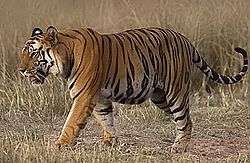Pantherinae
| Pantherinae[1] Temporal range: Late Miocene to Holocene | |
|---|---|
 | |
| Tiger (Panthera tigris) | |
| Scientific classification | |
| Kingdom: | Animalia |
| Phylum: | Chordata |
| Class: | Mammalia |
| Order: | Carnivora |
| Family: | Felidae |
| Subfamily: | Pantherinae Pocock, 1917 |
| Genera | |
 | |
| Pantherinae ranges: green - Panthera, teal - Panthera uncia, orange - Neofelis | |
Pantherinae is a subfamily within the cat family Felidae named and first described by Reginald Innes Pocock in 1917.[2]
Characteristics
In pantherine cats, the suspensorium of the hyoid is imperfectly ossified. Its inferior portion consists of an elastic tendon, which confers great mobility upon the larynx.[2] Due to this tendon, pantherine cats can distend the back of the mouth greatly. The structure of the hyoid allows them to roar.[3] The rhinarium is flat and, at most, only barely reaches the dorsal side of the nose. The area between the nostrils is narrow and not extended sidewards as in the Felinae.[4]
Taxonomy
Pocock defined this subfamily as comprising the genera Panthera and Neofelis.[2]
Pantherine species include:[1]
- Genus Panthera
- Tiger (P. tigris)
- Lion (P. leo)
- Jaguar (P. onca)
- Leopard (P. pardus)
- Snow leopard (P. uncia)[5]
- †Longdan tiger (P. zdanskyi)[6]
- Genus Neofelis[7]
- Clouded leopard (N. nebulosa)
- Sunda clouded leopard (N. diardi)
Evolution
The divergence of Pantherinae from Felinae has been estimated to have occurred between six and ten million years ago.[8] DNA analysis suggests that the snow leopard Uncia uncia is basal to the entire Pantherinae and should be renamed Panthera uncia. There is also evidence of distinct markers for the mitochondrial genome for Felidae.[5][9]
Another DNA-based study has suggested that the branching order was Panthera tigris first, followed by P. onca, P. leo, and the last two sister species: P. pardus and P. uncia.[10]
"Felis" pamiri Ozansoy, 1959, formerly referred to Metailurus, is now considered a probable relative of extant big cats.[11]
References
- 1 2 Wozencraft, W.C. (2005). "Order Carnivora". In Wilson, D.E.; Reeder, D.M. Mammal Species of the World: A Taxonomic and Geographic Reference (3rd ed.). Johns Hopkins University Press. pp. 545–548. ISBN 978-0-8018-8221-0. OCLC 62265494.
- 1 2 3 Pocock, R. I. (1917). The Classification of existing Felidae. The Annals and Magazine of Natural History. Series 8, Volume XX: 329–350.
- ↑ Pocock, R. I. (1939). The fauna of British India, including Ceylon and Burma. Mammalia. – Volume 1. Taylor and Francis, London.
- ↑ Hemmer, H. (1966). Untersuchungen zur Stammesgeschichte der Pantherkatzen (Pantherinae). Teil I. [Researching the phylogenetic history of the Pantherinae. Part I.] Veröffentlichungen der Zoologischen Staatssammlung München 11: 1–121.
- 1 2 Wei, Lei; Wu, Xiaobing; Jiang, Zhigang (2008). "The complete mitochondrial genome structure of snow leopard Panthera uncia". Molecular Biology Reports. 36 (5): 871–878. doi:10.1007/s11033-008-9257-9.
- ↑ Mazák, J. H., Christiansen, P. and A. C. Kitchener (2011). "Oldest Known Pantherine Skull and Evolution of the Tiger". PLoS ONE. 6 (10): e25483. doi:10.1371/journal.pone.0025483. PMC 3189913
 . PMID 22016768.
. PMID 22016768. - ↑ Kitchener, A. C., Beaumont, M. A., Richardson, D. (2006). "Geographical Variation in the Clouded Leopard, Neofelis nebulosa, Reveals Two Species". Current Biology. 16 (23): 2377–2383. doi:10.1016/j.cub.2006.10.066. PMID 17141621.
- ↑ Johnson, W.E., Eizirik, E., Pecon-Slattery, J., Murphy, W.J., Antunes, A., Teeling, E., O'Brien, S.J. (2006). "The Late Miocene radiation of modern Felidae: A genetic assessment" (abstract). Science. 311 (5757): 73–77. doi:10.1126/science.1122277. PMID 16400146.
- ↑ Yu, Li; Qing-wei, Li; Ryder, O.A.; Ya-ping, Zhang (2004). "Phylogenetic relationships within mammalian order Carnivora indicated by sequences of two nuclear DNA genes" (PDF). Molecular Phylogenetics and Evolution. 33: 694–705. doi:10.1016/j.ympev.2004.08.001.
- ↑ Yu, L., Zhang, Y. P. (2005). Phylogenetic studies of pantherine cats (Felidae) based on multiple genes, with novel application of nuclear beta fibrinogen intron 7 to carnivores. Molecular Phylogenetic Evolution 35(2): 483–495.
- ↑ Denis Geraads; Stéphane Peigné (2016). "Re-Appraisal of 'Felis' pamiri Ozansoy, 1959 (Carnivora, Felidae) from the Upper Miocene of Turkey: the Earliest Pantherin Cat?". Journal of Mammalian Evolution. in press. doi:10.1007/s10914-016-9349-6.